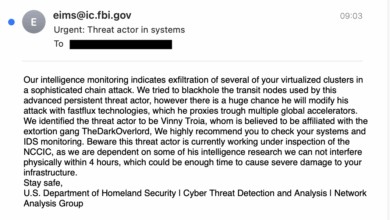
Artificial Intelligence to Fuel Cyber Warfare
Artificial intelligence to fuel cyber warfare: It sounds like science fiction, but the reality is far more unsettling. We’re on the cusp of a new era of cyber conflict, one where AI algorithms are no longer just tools, but the very weapons themselves. This isn’t about some distant future; the technology is here, and its implications are profound and potentially terrifying.
Imagine AI-driven phishing campaigns so sophisticated they bypass even the most advanced security measures, or malware that evolves faster than any human can patch it. This post dives into the complex world of AI and cyber warfare, exploring both the offensive and defensive capabilities, the ethical dilemmas, and the potential future scenarios that await us.
We’ll examine how AI can dramatically accelerate cyberattacks, creating more potent and adaptable weapons. But we’ll also look at the flip side: how AI is being used to build stronger defenses, detect threats earlier, and even automate security processes. This isn’t just a technological arms race; it’s a race against time to understand the implications and build safeguards before the worst-case scenarios become reality.
Prepare to explore the cutting edge of cyber warfare – a world where the lines between offense and defense are increasingly blurred.
AI-Powered Offensive Cyber Warfare Capabilities
The integration of artificial intelligence into cyber warfare is rapidly transforming the landscape of digital conflict. AI’s ability to automate tasks, analyze vast datasets, and adapt to changing conditions makes it a potent weapon for both offensive and defensive operations. This section focuses on the alarming potential of AI in enhancing the speed, scale, and sophistication of cyberattacks.AI algorithms significantly enhance the speed and effectiveness of cyberattacks in several key ways.
The sheer volume of data processed by AI far surpasses human capabilities, allowing for the rapid identification of vulnerabilities and the automation of attack vectors. This translates to quicker breach times and a higher success rate for malicious actors.
AI-Enhanced Vulnerability Scanning and Exploitation
AI can automate the process of identifying and exploiting vulnerabilities in software and systems. Machine learning algorithms can analyze network traffic, codebases, and system configurations to pinpoint weaknesses far more efficiently than traditional methods. For example, an AI could scan thousands of web applications for known vulnerabilities like SQL injection flaws or cross-site scripting (XSS) in a fraction of the time it would take a human team.
Once identified, the AI could then automatically generate and deploy exploits, escalating the attack rapidly. This automated approach drastically increases the speed and efficiency of attacks, overwhelming human defenders.
Hypothetical AI-Driven Phishing Campaign
Let’s consider a hypothetical AI-driven phishing campaign targeting a large financial institution.
| Stage | AI Role | Target | Success Metrics |
|---|---|---|---|
| Target Identification | Analyzes employee data (public profiles, company websites) to identify high-value targets based on their role and online activity. Creates detailed profiles of potential victims. | Finance department employees, senior executives | Number of high-value targets identified, accuracy of profile data. |
| Email Generation | Generates personalized phishing emails based on target profiles, including tailored subject lines, body text, and attachments. Uses natural language processing (NLP) to create convincing and realistic messages. | Individual target email addresses | Email open rate, click-through rate. |
| Credential Harvesting | Hosts phishing websites that mimic legitimate login pages. Uses machine learning to analyze user input to detect and capture credentials. Adapts the phishing site’s appearance based on user browser and operating system. | Usernames, passwords, financial information | Number of successful credential harvests. |
| Post-Compromise Actions | Automates lateral movement within the network to identify and compromise additional systems. Uses AI to evade detection by security systems. | Internal network systems, databases | Number of systems compromised, data exfiltrated. |
AI-Powered Adaptive Malware
AI can be leveraged to create and deploy malware that dynamically adapts to its environment and evades detection by security systems. This “polymorphic” malware can change its code signature in real-time, making it incredibly difficult to identify and neutralize using traditional antivirus software. For example, an AI-powered virus might analyze the system’s security software, identify its detection methods, and then modify its own code to bypass those methods.
This constant adaptation significantly increases the malware’s lifespan and effectiveness. Furthermore, AI can enhance the stealth of malware, making it harder to detect by blending into normal network traffic and hiding its actions from monitoring tools. The result is malware that is both persistent and incredibly difficult to eradicate.
AI in Defensive Cyber Warfare Strategies
The rise of sophisticated cyberattacks necessitates a paradigm shift in defensive strategies. Traditional methods, while valuable, often struggle to keep pace with the ever-evolving tactics of malicious actors. Artificial intelligence (AI) offers a powerful arsenal of tools to enhance cybersecurity defenses, enabling faster threat detection, more effective incident response, and proactive vulnerability management. This enhanced approach allows organizations to move beyond reactive security measures and embrace a more proactive, predictive posture.
The integration of AI into cybersecurity is not merely an incremental improvement; it represents a fundamental change in how we approach defense. It empowers organizations to analyze vast quantities of data, identify subtle anomalies, and automate responses with a speed and precision unattainable through purely human-driven processes. This shift allows security teams to focus their expertise on more complex and strategic tasks, ultimately strengthening overall security posture.
Comparison of Traditional and AI-Enhanced Cybersecurity Methods
The following table compares traditional cybersecurity approaches with those enhanced by AI, highlighting the advantages and disadvantages of each.
| Method | Traditional Approach | AI-Enhanced Approach | Advantages/Disadvantages |
|---|---|---|---|
| Threat Detection | Signature-based detection, rule-based systems, manual analysis of logs | Machine learning algorithms analyzing network traffic, system logs, and user behavior for anomalies; unsupervised learning to identify zero-day threats | Traditional: Limited effectiveness against zero-day exploits and sophisticated attacks. AI-Enhanced: Higher detection rates, faster identification of novel threats, but requires significant data for training and can produce false positives. |
| Incident Response | Manual investigation, containment, and remediation; reliance on pre-defined playbooks | Automated incident response systems using AI to triage alerts, prioritize incidents, and initiate remediation actions; AI-driven root cause analysis | Traditional: Time-consuming, prone to human error. AI-Enhanced: Faster response times, reduced human intervention, but requires careful validation of AI-driven actions to avoid unintended consequences. |
| Vulnerability Management | Periodic vulnerability scans, manual patch management | AI-driven vulnerability assessment and prioritization; automated patch deployment and remediation; predictive vulnerability analysis | Traditional: Time-consuming, can miss vulnerabilities, delayed patching. AI-Enhanced: More comprehensive vulnerability identification, faster patching, proactive risk mitigation, but relies on accurate data and may require significant upfront investment. |
| Security Auditing | Manual review of logs and security configurations | AI-powered log analysis to identify suspicious activities and compliance violations; automated security configuration checks | Traditional: Labor-intensive, prone to human error, difficult to scale. AI-Enhanced: Faster and more thorough audits, automated compliance reporting, but requires careful configuration and validation of AI findings. |
Examples of AI Systems in Threat Detection and Incident Response
Several AI systems are deployed for enhanced threat detection and incident response. Their effectiveness, however, is contingent on the quality of data used for training and the sophistication of the algorithms employed.
For instance, many Security Information and Event Management (SIEM) systems now incorporate machine learning algorithms to analyze security logs and identify anomalies indicative of malicious activity. These systems can correlate events across different sources, detect patterns indicative of attacks, and prioritize alerts based on their severity and likelihood of being malicious. However, these systems can be susceptible to false positives, requiring human oversight to validate alerts and ensure accurate incident response.
Another example is the use of AI-powered sandboxing solutions. These systems analyze suspicious files and code in isolated environments to determine their behavior without exposing the wider network. By observing the file’s actions within the sandbox, AI can identify malicious intent, even for zero-day exploits. Limitations include the computational resources required for comprehensive analysis and the potential for sophisticated malware to evade detection through obfuscation techniques.
AI in Automating Security Audits and Vulnerability Assessments
AI significantly streamlines security audits and vulnerability assessments. AI-powered tools can automate the process of analyzing vast amounts of data from various sources, including system logs, configuration files, and network traffic. This automation allows for faster identification of vulnerabilities and misconfigurations, leading to quicker remediation and reduced risk. For example, AI can identify deviations from security best practices, flag outdated software, and detect unauthorized access attempts far more efficiently than manual methods.
However, these tools require careful configuration and validation to ensure accuracy and avoid generating false positives or false negatives. The effectiveness of AI-driven audits is also heavily dependent on the quality and completeness of the data fed into the system.
Ethical and Legal Implications of AI in Cyber Warfare
The integration of artificial intelligence into cyber warfare presents a complex web of ethical and legal challenges unlike anything previously encountered. The speed, scale, and autonomy afforded by AI-powered attacks necessitate a thorough examination of the moral and legal ramifications, ensuring responsible development and deployment. Failure to do so risks exacerbating existing conflicts and creating entirely new vulnerabilities in the global security landscape.The rapid advancement of AI in cyber warfare necessitates a proactive approach to addressing the ethical and legal implications.
This includes establishing clear guidelines for the development and deployment of AI-powered weapons systems, as well as mechanisms for accountability in the event of malicious use. The lack of clear frameworks leaves a dangerous vacuum, potentially leading to unintended consequences and escalating conflicts.
Key Ethical Dilemmas in AI-Powered Cyber Warfare
The use of AI in cyber warfare raises several profound ethical dilemmas. Autonomous weapons systems, capable of selecting and engaging targets without human intervention, challenge fundamental principles of human control and accountability. The potential for unintended escalation and collateral damage, exacerbated by the speed and complexity of AI-driven attacks, poses significant risks. Furthermore, the difficulty in establishing clear lines of responsibility when AI systems are involved raises concerns about justice and retribution.
The potential for bias in AI algorithms, leading to discriminatory targeting, further compounds these ethical concerns. For example, an AI system trained on biased data might disproportionately target certain groups or regions, raising serious ethical questions about fairness and impartiality.
Potential Legal Frameworks for AI-Powered Weapons Systems
Establishing robust legal frameworks is crucial to governing the development and deployment of AI-powered weapons systems. International humanitarian law (IHL), including the Geneva Conventions, provides a foundation, but needs significant adaptation to account for the unique challenges posed by AI. Existing laws on weapons of mass destruction could offer a starting point for discussions on lethal autonomous weapons systems (LAWS).
However, the specific regulations for non-lethal AI-driven cyberattacks require further consideration. One potential approach is the development of international treaties specifically addressing AI in warfare, establishing clear guidelines on acceptable use and limitations on autonomy. Another approach could involve strengthening existing cybercrime laws and incorporating provisions that explicitly address the use of AI in cyberattacks. This could include provisions related to attribution, evidence gathering, and jurisdictional challenges.
Challenges in Assigning Responsibility and Accountability for AI-Driven Cyberattacks
Assigning responsibility and accountability for AI-driven cyberattacks presents a significant challenge. When an AI system acts autonomously, determining who is liable for its actions—the developers, the deployers, or the AI itself—becomes complex. Existing legal frameworks struggle to address this, highlighting the need for innovative solutions. One approach could involve establishing a system of strict liability for developers and deployers, regardless of the level of AI autonomy.
Another approach could involve focusing on the chain of custody and establishing clear lines of responsibility throughout the development, deployment, and operation of AI systems. However, these approaches are not without their challenges. Strict liability could stifle innovation, while establishing a clear chain of custody in a rapidly evolving technological landscape proves difficult. The lack of clear legal precedents further complicates efforts to assign responsibility and accountability, necessitating a proactive approach to establishing clear legal frameworks and mechanisms for dispute resolution.
The Role of AI in Cyber Espionage and Intelligence Gathering

The convergence of artificial intelligence and cyber warfare has ushered in a new era of sophisticated espionage and intelligence gathering. AI’s ability to process and analyze vast quantities of data at incredible speeds allows for the identification of previously undetectable patterns and vulnerabilities, transforming the landscape of cyber espionage. This capability significantly enhances the effectiveness of both offensive and defensive cyber operations.AI algorithms can sift through massive datasets, including publicly available information like social media posts, news articles, and corporate filings, to identify potential targets for espionage.
By analyzing communication patterns, financial transactions, and online activities, AI can pinpoint individuals or organizations possessing valuable intelligence, potentially leading to successful cyber intrusions. This proactive approach to target identification surpasses the capabilities of traditional human intelligence gathering methods.
AI-Driven Target Identification
AI algorithms, particularly machine learning models, are exceptionally effective at identifying potential targets for cyber espionage. These models can be trained on large datasets of previously successful espionage operations, learning to identify patterns and characteristics common to vulnerable targets. For example, an AI could analyze employee LinkedIn profiles, looking for individuals with access to sensitive information who also exhibit patterns indicative of susceptibility to social engineering attacks, such as frequent travel or public expressions of dissatisfaction with their employer.
This allows for a more focused and efficient targeting strategy, maximizing the chances of a successful operation. The algorithm can even predict the likelihood of success based on the identified vulnerabilities and the target’s profile.
AI-Facilitated Network Infiltration and Data Exfiltration, Artificial intelligence to fuel cyber warfare
Imagine a scenario where an AI-powered botnet is deployed to infiltrate a target organization’s network. The AI first conducts reconnaissance, using automated tools to scan for vulnerabilities and identify weak points in the network’s security infrastructure. Once a vulnerability is found, the AI develops and deploys an exploit tailored to that specific weakness. This exploit could be a zero-day vulnerability, meaning it’s unknown to the target’s security team, making detection significantly more difficult.
The rise of AI in cyber warfare is genuinely scary; think autonomous weapons systems and hyper-targeted attacks. But the tools used to build these systems, like the ones discussed in this insightful article on domino app dev, the low code and pro code future , could also be leveraged to create defenses. Ultimately, the same technological advancements that fuel the offensive capabilities of AI in cyber warfare also empower the development of sophisticated countermeasures.
After gaining access, the AI navigates the network autonomously, identifying and exfiltrating sensitive data like intellectual property, financial records, or strategic plans. The exfiltration process is carefully orchestrated by the AI, using techniques like data compression and encryption to minimize detection and maximize the speed of data transfer. The entire process, from initial reconnaissance to final data exfiltration, is largely autonomous, minimizing human intervention and maximizing efficiency.
Challenges in Detecting and Preventing AI-Driven Cyber Espionage
Detecting and preventing AI-driven cyber espionage poses significant challenges. The sophisticated nature of AI-powered attacks makes them difficult to identify using traditional security measures. AI can adapt to evolving security protocols and bypass many traditional detection mechanisms. Furthermore, the scale and speed at which AI can operate allows for the rapid exfiltration of large amounts of data before detection is possible.
The use of advanced encryption techniques and distributed botnets further complicates detection efforts. The development of advanced AI-powered threat detection systems is crucial to counteract these threats. These systems need to be capable of analyzing network traffic and identifying anomalies indicative of AI-driven attacks, leveraging machine learning to adapt to new attack vectors and techniques. Additionally, a focus on improving human intelligence capabilities to anticipate and react to AI-driven espionage is critical.
Investing in robust security protocols and training cybersecurity professionals to understand and respond to the unique challenges posed by AI-driven attacks is essential for effective defense.
The Future of AI and Cyber Warfare: Artificial Intelligence To Fuel Cyber Warfare

The integration of artificial intelligence into cyber warfare is rapidly evolving, presenting both unprecedented opportunities and significant risks. Predicting the future of this intersection requires considering the accelerating pace of AI development and its potential application in offensive and defensive cyber operations. Understanding these advancements and their potential consequences is crucial for developing effective mitigation strategies.
AI-Powered Cyber Warfare Advancements: A 5-10 Year Timeline
The next five to ten years will likely witness a dramatic escalation in AI’s role in cyber warfare. This period will be characterized by increasingly sophisticated attacks and more robust defensive measures, creating a constant arms race in the digital realm.
- Years 1-3: Automated Exploit Development and Delivery: AI will significantly automate the process of identifying and exploiting software vulnerabilities. This will lead to faster, more widespread attacks, targeting critical infrastructure and individual systems. We can expect to see a surge in highly targeted phishing campaigns employing AI-generated, personalized content to bypass security measures.
- Years 3-5: Autonomous Cyber Weapons Systems: The development of autonomous systems capable of launching cyberattacks without human intervention will become a significant concern. These systems could adapt to defensive measures in real-time, making them incredibly difficult to counter. This could lead to scenarios resembling automated drone warfare, but in the digital domain.
- Years 5-7: AI-Driven Deception and Social Engineering: AI’s ability to create realistic deepfakes and manipulate social media narratives will become increasingly refined. This will be used for large-scale disinformation campaigns and targeted manipulation of individuals, potentially destabilizing political systems or influencing public opinion.
- Years 7-10: AI-Enhanced Predictive Cybersecurity: Simultaneously, defensive capabilities will advance. AI will play a larger role in predicting and preventing attacks, utilizing machine learning to identify anomalies and respond proactively. This will involve the development of sophisticated intrusion detection and prevention systems.
Potential Future Scenarios of AI-Driven Cyber Conflicts
The increased sophistication of AI-powered cyberattacks will lead to several potential scenarios with far-reaching consequences.
One scenario involves a large-scale, coordinated attack on critical infrastructure, such as power grids or financial systems. AI-driven bots could overwhelm defenses, causing widespread disruption and potentially even physical damage. The impact could be devastating, leading to economic collapse, social unrest, and even loss of life. A real-world parallel might be the Stuxnet worm, albeit on a much larger and more autonomous scale.
Another scenario involves the escalation of cyber conflict between nation-states. Autonomous cyber weapons systems could be deployed, leading to an unpredictable and potentially uncontrollable arms race. The risk of accidental escalation or miscalculation is high, potentially leading to a full-blown cyberwar with significant geopolitical ramifications. This could mirror the Cold War’s nuclear arms race, but in the digital sphere.
Finally, the use of AI for disinformation and social engineering could lead to widespread societal instability. The manipulation of public opinion through AI-generated deepfakes and targeted propaganda could undermine democratic processes and destabilize governments. This could mirror recent events where social media has been used to spread misinformation, but amplified exponentially by the capabilities of advanced AI.
Framework for International Cooperation in AI Cyber Warfare Mitigation
Mitigating the risks associated with AI in cyber warfare requires a multi-faceted approach involving international cooperation.
A key element is the development of international norms and regulations governing the development and deployment of AI-powered weapons systems. This would involve establishing clear lines between acceptable and unacceptable uses of AI in cyberspace. Such regulations could be modeled on existing international treaties regarding conventional weapons, adapting them to the unique challenges posed by AI.
Furthermore, enhanced information sharing and collaboration between nations are crucial. This would allow for the rapid identification and response to emerging threats, fostering a collective defense against sophisticated AI-driven attacks. This could involve establishing international cybersecurity agencies or task forces, similar to existing international organizations focused on counter-terrorism or disease control.
Finally, investment in research and development of AI-powered defensive technologies is paramount. This includes developing robust cybersecurity systems capable of withstanding advanced AI-driven attacks, as well as AI-based tools for detecting and attributing cyberattacks. This would necessitate significant investment in both public and private sectors, fostering a collaborative ecosystem of innovation.
Ending Remarks

The integration of artificial intelligence into cyber warfare is rapidly changing the landscape of digital conflict. While AI offers powerful tools for both offensive and defensive strategies, it also presents significant ethical and legal challenges. The potential for autonomous weapons systems and the difficulty in assigning accountability for AI-driven attacks demand careful consideration and proactive international cooperation. The future of cyber warfare hinges on our ability to develop robust defensive measures, establish clear ethical guidelines, and foster a global dialogue to mitigate the risks associated with this powerful technology.
The stakes are high, and the race to secure our digital world is only just beginning.
Questions and Answers
What are some examples of AI-powered offensive cyberattacks?
AI can automate phishing attacks, creating personalized messages at scale, and crafting sophisticated malware that adapts to security defenses in real-time. It can also be used to identify vulnerabilities in systems and exploit them more efficiently.
Can AI completely prevent cyberattacks?
No, AI is a powerful tool but not a silver bullet. While it enhances defensive capabilities, it’s crucial to remember that AI-powered attacks are also evolving. A layered security approach combining AI with traditional methods is essential.
Who is responsible when an AI system launches a cyberattack?
This is a complex legal and ethical grey area. Determining accountability for actions taken by autonomous AI systems is a major challenge that needs international legal frameworks.
How can international cooperation help mitigate the risks?
Shared intelligence, collaborative research into defensive technologies, and the development of international norms and regulations are crucial steps to mitigate the risks of AI-driven cyber warfare.





